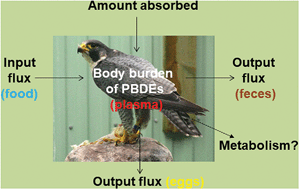Mass balance study of brominated flame retardants in female captive peregrine falcons†
Abstract
Little is known about brominated flame retardant (BFR) dynamics in birds, especially large molecules such as decabromodiphenyl ether (BDE-209). In particular, bioaccumulation from food and transfer dynamics to eggs are poorly understood. Therefore, an input–output mass balance study of tri–decaBDEs, DBDPE and HBCDD was performed in three female peregrine falcons from a captive breeding program by analyzing their naturally contaminated food (quail, chicken (cockerels)), plasma, feces and eggs. Predominant BFRs in cockerels and quail were BDE-209 and DBDPE, as well as HBCDD in quail. The predominant BFRs found in falcon plasma were BDE-209, -153 and -183, in eggs, HBCDD, BDE-209 and -153 and in feces, BDE-209. Mean absorption efficiencies (AE) for the tetra-octabrominated BDEs ranged from 84–100% and 70% for HBCDD. The AEs for BDE-206, -207, -208 and -209 varied due to the large variability seen for feces fluxes. All egg/plasma ratios for BDEs were similar and greater than one (range 1.1–2.7), including for BDE-209, indicating efficient transfer from females to the eggs. Excretion via egg-laying was approximately 6.0–29% of the initial, pre-breeding body burden of individual penta–decaBDE congeners, (15–45% for BDE-206). HBCDD was not detected in plasma but was found in eggs, also indicating efficient transfer and excretion via eggs. Input fluxes from food exceeded the output fluxes (feces, eggs) indicating considerable metabolism for tetra–octaBDEs, possibly also for the nona–decaBDEs and HBCDD. Bioaccumulation factors calculated from lipid weight concentrations in plasma and food (BAFp) were highest for BDE-208 (31), -153 (23), -209 (19) and -207 (16) and from eggs and food (BAFe), were highest for HBCDD (140), BDE-153 (41), -208 (42), BDE-207 (24) and BDE-209 (21). BAFe and BAFp values were below 10 for BDE-47, -99 and -100. For one falcon, egg results were available from three different years and estimated half-lives were 65 d (BDE-99), 624 d (BDE-153), 31 d (BDE-154), 349 d (BDE-183), 77 d (BDE-196) and 89 d (BDE-197).

- This article is part of the themed collection: Best Papers 2019 – Environmental Science: Processes & Impacts


 Please wait while we load your content...
Please wait while we load your content...